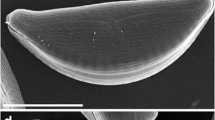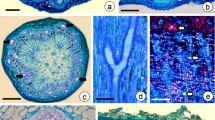Summary
The rootlets of the kinetic cilia form patterns of different types in the different turbellarian subgroups (cf. Rieger 1981). In the Acoela a rather complex system of ciliary rootlets is found in the epidermis (Dorey 1965; Hendelberg & Hedlund 1973; Bedini & Papi 1974). In the acoel Childia groenlandica (Levinsen) the four rootlets of each cilium make contact with those of adjacent cilia at two levels (Hendelberg & Hedlund 1974). Distinct granules are found in the interior of the main rootlets (Hendelberg & Hedlund 1974; Bedini & Papi 1974, Fig. 16) and basal bodies (Silveira 1972; Hendelberg & Hedlund 1974) of the epidermal kinetic cilia of acoels. Similar granules, probably of identical structure, can be seen in nemertodermatids, in the same positions (Tyler & Rieger 1977, Figs. 3 & 6). Such granules were studied in C. groenlandica with histochemical methods adapted for electron microscopy. Like Silveira (1972) I found the granules of the basal bodies to be Thiéry-positive, and thus evidently to be made up of or at least to contain polysaccharide material. The granules of the main rootlets were also found to be Thiéry-positive (Hendelberg 1976). Digestion experiments (Hendelberg & Hellmén 1978 and unpublished results) strongly support the concept that the granules are glycogen beta-particles.
We know that cilia can function as kinetic organelles without any rootlets. But we are still uncertain about the function of the rootlets when occurring. Most probably they form an anchorage, a function which may be favoured by branching rootlets making contact with each other. Another function which has been discussed is the transmittance of impulses regulating the ciliary beat. Glycogen granules represent an energy deposit. The functional implication of these granules in the interior of the ciliary rootlets and basal bodies is not clear. However, the observations raise the question of how energy is transmitted to the cilia. Are the ciliary rootlets, when occurring, involved? This question will be further discussed, with references, in a future full report on the digestion experiments (to be published elsewhere).
Similar content being viewed by others
References
Bedini, C. & Papi, F., 1974. Fine structure of the turbellarian epidermis. In: Eds. Riser, N. W. & Morse, M. P., Biology of the Turbellaria, New York: MacGraw-Hill, pp. 108–147.
Dorey, A. E., 1965. The organization and replacement of the epidermis in acoelous turbellarians. Q. J. microsc. Sci. 106: 147–172.
Hendelberg, J., 1976. Granules of glycogen beta-particle type demonstrated in epidermal ciliary rootlets of acoelous turbellarians. J. Ultrastruct. Res. 54: 491.
Hendelberg, J. & Hedlund, K. O., 1973. Electron microscope studies of the junctions between ciliary rootlets and the orientation of ciliary axonemes in the epidermis of acoelous turbellarians. J. Ultrastruct. Res. 44: 440.
Hendelberg, J. & Hedlund, K. O., 1974. On the morphology of the epidermal ciliary rootlet system of the acoelous turbellarian Childia groenlandica. Zoon 2: 13–24.
Hendelberg, J. & Hellmén, E., 1978. Electron microscope studies of the effects of amylase digestion on granules occurring in basal bodies and ciliary rootlets. J. Ultrastruct. Res. 63: 106–107.
Rieger, R. M., 1981. Morphology of the Turbellaria at the ultrastructure level. In: Eds. Schockaert, E. R. & Ball, I. R. Turbellaria. Proc. of Third Int. Symp. Hydrobiologia. This volume.
Silveira, M., 1972. Association of polysaccharide material with certain flagellar and ciliary structures in turbellarian flatworms. Revue Microsc. Electron. 1:96.
Tyler, S. & Rieger, R. M., 1977. Ultrastructural evidence for the position of the Nemertodermatida (Turbellaria). Acta Zool. fenn. 154: 193–207.
Author information
Authors and Affiliations
Rights and permissions
About this article
Cite this article
Hendelberg, J. The system of epidermal ciliary rootlets in Turbellaria. Hydrobiologia 84, 240 (1981). https://doi.org/10.1007/BF00026185
Issue Date:
DOI: https://doi.org/10.1007/BF00026185




